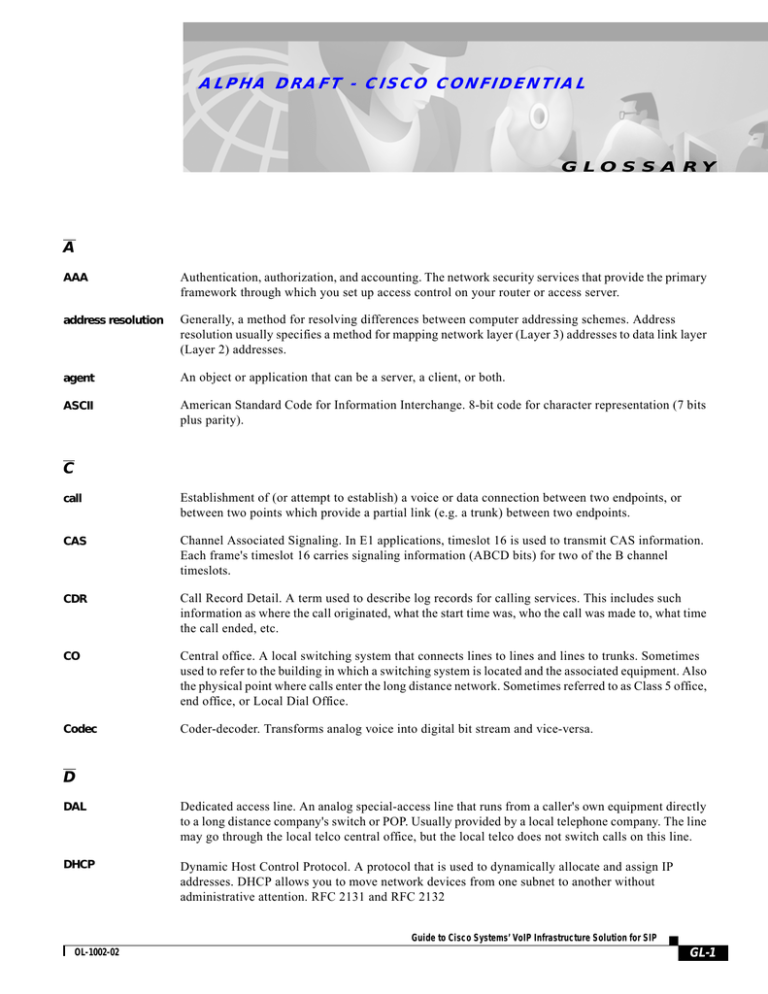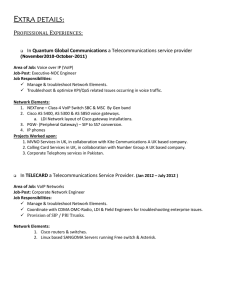alpha draft - cisco confidential acd
advertisement

ALPHA DRAFT - CISCO CONFIDENTIAL G LO S SA RY A AAA Authentication, authorization, and accounting. The network security services that provide the primary framework through which you set up access control on your router or access server. address resolution Generally, a method for resolving differences between computer addressing schemes. Address resolution usually specifies a method for mapping network layer (Layer 3) addresses to data link layer (Layer 2) addresses. agent An object or application that can be a server, a client, or both. ASCII American Standard Code for Information Interchange. 8-bit code for character representation (7 bits plus parity). C call Establishment of (or attempt to establish) a voice or data connection between two endpoints, or between two points which provide a partial link (e.g. a trunk) between two endpoints. CAS Channel Associated Signaling. In E1 applications, timeslot 16 is used to transmit CAS information. Each frame's timeslot 16 carries signaling information (ABCD bits) for two of the B channel timeslots. CDR Call Record Detail. A term used to describe log records for calling services. This includes such information as where the call originated, what the start time was, who the call was made to, what time the call ended, etc. CO Central office. A local switching system that connects lines to lines and lines to trunks. Sometimes used to refer to the building in which a switching system is located and the associated equipment. Also the physical point where calls enter the long distance network. Sometimes referred to as Class 5 office, end office, or Local Dial Office. Codec Coder-decoder. Transforms analog voice into digital bit stream and vice-versa. D DAL Dedicated access line. An analog special-access line that runs from a caller's own equipment directly to a long distance company's switch or POP. Usually provided by a local telephone company. The line may go through the local telco central office, but the local telco does not switch calls on this line. DHCP Dynamic Host Control Protocol. A protocol that is used to dynamically allocate and assign IP addresses. DHCP allows you to move network devices from one subnet to another without administrative attention. RFC 2131 and RFC 2132 Guide to Cisco Systems’ VoIP Infrastructure Solution for SIP OL-1002-02 GL-1 Glossary ALPHA DRAFT - CISCO CONFIDENTIAL dial peer An addressable call endpoint. In Voice over IP (VoIP), there are two types of dial peers: POTS and VoIP. dial plan A description of the dialing arrangements for customer use on a network. DNIS Dialed Number Identification Service. A feature of 800 and 900 lines that provides the number the caller dialed. DNIS allows one trunk group to service multiple applications, thus requiring fewer phone lines. For example, you could give one 800 number to callers in New York, one to callers in Chicago, and one to callers in LA. With DNIS, one trunk could be used to answer all those calls, playing a different, customized recording for each number called. DNS Domain Name System. System used in the Internet for translating names of network nodes into addresses. DSL Digital Subscriber Line. Public network technology that delivers high bandwidth over conventional copper wiring at limited distances. There are four types of DSL: ADSL, HDSL, SDSL, and VDSL. All are provisioned via modem pairs, with one modem located at a central office and the other at the customer site. Because most DSL technologies do not use the whole bandwidth of the twisted pair, there is room remaining for a voice channel. DTMF Dual-tone multifrequency: The paired, high- and low-frequency tones that make up touch-tone dialing. E E1 Wide-area digital transmission scheme. E1 is the European equivalent of a T1 line. The E1's higher clock rate (2.048 MHz) allows for 32 64 Kbps channels, which include one channel for framing and one channel for D-channel information. E.164 ITU-T recommendation for international telecommunication numbering, especially in ISDN, BISDN, and SMDS. An evolution of standard telephone numbers. endpoint SIP or H.323 terminal or gateway. An endpoint can call and be called. It generates and terminates the information stream. G G.729 An ITU-T algorithm for voice encoding that produces an 80-bit voice sample every 10 msec (bit rate of 8 kbps). The codec works in blocks of 10 msec and so it is possible to generate frames of multiple 10 msec duration. gateway The server that connects the VoIP network with PBXs and PSTN devices. Guide to Cisco Systems’ VoIP Infrastructure Solution for SIP GL-2 OL-1002-02 Glossary ALPHA DRAFT - CISCO CONFIDENTIAL H H.323 Recommendation from the ITU that sets standards for multimedia communications over IP networks. It also addresses call control, multimedia management, and bandwidth management. HTTP Hypertext Transfer Protocol. The protocol used by Web browsers and Web servers to transfer files, such as text and graphic files. HTTP digest A password-based authentication method supported by LDAP servers. I ICMP Internet Control Message Protocol. A network-layer Internet protocol that reports errors and provides other information relevant to IP packet processing. RFC792 IE Information element. IETF Internet Engineering Task Force. Task force consisting of over 80 working groups responsible for developing Internet standards. The IETF operates under the auspices of ISOC. IMAP Internet Message Access Protocol. A UNIX server protocol allowing users to scan message headers, download selected messages, and administer e-mail folders. IP Internet Protocol. A network-layer protocol in the TCP/IP stack that offers a connectionless internetwork service. IP provides features for addressing, type-of-service (ToS) specification, fragmentation and reassembly, and security. RFC791 IPSec IP Security. An IETF standard that is used to provide security for transmission of sensitive information over unprotected networks such as the Internet. IPSec acts at the network layer, protecting and authenticating IP packets between participating IPSec devices (“peers”), such as Cisco routers. ISDN Integrated Services Digital Network. A communications protocol, offered by telephone companies, that permits telephone networks to carry data, voice, and other traffic. ISP Internet service provider. Company that provides Internet access to other companies and individuals. ITU International Telecommunications Union. Established by the United Nations, with membership from virtually every world government. Three primary goals are: defining and adopting telecommunications standards; regulating use of the radio frequency spectrum; and furthering world-wide telecommunications development. IVR Integrated voice response. Consists of simple voice prompting and digit collection to authenticate user and identify call destination. Guide to Cisco Systems’ VoIP Infrastructure Solution for SIP OL-1002-02 GL-3 Glossary ALPHA DRAFT - CISCO CONFIDENTIAL L LDAP Lightweight Directory Access Protocol. An emerging software protocol for enabling anyone to locate organizations, individuals, and other resources such as files and devices in a network, whether on the Internet or on a corporate intranet. LDAP is a “lightweight” (smaller amount of code) version of DAP (Directory Access Protocol), which is part of X.500, a standard for directory services in a network. LEC Local exchange carrier. Local or regional telephone company that owns and operates a telephone network and the customer lines that connect to it. location server A device that processes requests (typically from a redirect or proxy server) to provide information about the possible location of a target end user. M MGC Media gateway controller. A device that provides control of media and signalling gateways. MGCP Media Gateway Control Protocol. Protocol that helps bridge the gap between circuit-switched and IP networks. A combination of Internet Protocol Device Control (IPDC) and Simple Gateway Control Protocol (SGCP). MGCP allows external control and management of data communications devices, or “media gateways” at the edge of multiservice packet networks by software programs. MIB Management Information Base - A directory of logical names of information resources residing in a network and pertaining to the network's management. MIME Multipurpose Internet Mail Extension. A set of extensions to the SMTP message syntax allowing various file types to be attached to text mail. Mu-law The PCM voice-coding and companding standard used in Japan and North America. A PCM algorithm yielding a raw 64-kbps transmission rate. N name mapping Generally, the process of associating a name with a network location. NTP Network Time Protocol. The recommended protocol for synchronizing the time of hosts in the uOne network. P PBX Private branch exchange. Privately-owned central switching office. PCM Pulse-code modulation. The form of modulation in which the information signals are sampled at regular intervals and a series of pulses in coded form are transmitted representing the amplitude of the information signal at that time. For T1 applications, a method of converting successive (every 125 us) analog samples of a voice waveform to successive 8-bit codes, to be transmitted in an 8-bit timeslot of a T1 frame. In “robbed bit” frames, only the most significant 7 bits are used to encode the sample. The total bit rate for such a channel is (8000 samples/sec) x (8-bits/sample) = 64000 bits/sec. Guide to Cisco Systems’ VoIP Infrastructure Solution for SIP GL-4 OL-1002-02 Glossary ALPHA DRAFT - CISCO CONFIDENTIAL POTS Plain Old Telephone Service. Basic telephone service supplying standard single line telephones, telephone lines, and access to the Public Switched Telephone Network. PRA Primary Rate Access. A Canadian term synonymous with ISDN PRI. PRI Primary Rate Interface. PRI is an ISDN interface to primary rate access. Primary rate access consists of a single 64 Kbps D channel plus 23 T1 or 30 E1 B channels for voice or data. proxy server An intermediate device that receives SIP requests from a client and then initiates requests on the client’s behalf. PSTN Public Switched Telephone Network. PSTN refers to the local telephone company. Q Q.931 Call-signaling protocol for setup and termination of calls. Q.SIG Q Signaling. An inter-PBX signaling protocol for networking PBX supplementary services in a multior uni-vendor environment. R RADIUS Remote Authentication Dial-In User Service. An authentication and accounting system used by many Internet service providers (ISPs). RAS Registration, Admission, Status. Protocol used in the H.323 protocol suite for discovering and interacting with a Gatekeeper. redirect server A device that receives SIP requests, strips out the address in the request, checks its address tables for any other addresses that may be mapped to the one in the request, and then returns the results of the address mapping to the client. registrar server A device that processes requests from UACs for registration of their current location. Registrar servers are often co-located with a redirect or proxy server. RFC Request For Comments. Document series used as the primary means for communicating information about the Internet. Some RFCs are designated by the IAB as Internet standards. Most RFCs document protocol specifications such as Telnet and FTP, but some are humorous or historical. RFCs are available online from numerous sources. RPC Remote Procedure Call. An external form of communication that allows objects to communicate with each other over the network. The RPC programming interface is built into each server's Client and Server subsystems to provide external communication among servers. RSVP IETF specification that allows applications to request dedicated bandwidth. Guide to Cisco Systems’ VoIP Infrastructure Solution for SIP OL-1002-02 GL-5 Glossary ALPHA DRAFT - CISCO CONFIDENTIAL RTP/RTCP Real-Time Transfer Protocol/RTP Control Protocol. An IETF specification for audio and video signaling management. Allows applications to synchronize and spoil audio and video information. RTP connections are established between DAP servers across the Internet after voice has been converted to IP format. RTSP Real-Time Streaming Protocol. Proposed standard for controlling streaming data over the World Wide Web. S SAP Session Announcement Protocol. A protocol used to assist in the advertisement of multicast multimedia conferences and other multicast sessions, and to communicate the relevant session setup information to prospective participants. SDP Session Description Protocol. A protocol used to describe the characteristics of multimedia sessions for the purposes of session announcement, session invitation, and other forms of multimedia session initiation. RCS 2327 signaling Process of sending a transmission signal over a physical medium for purposes of communication. SIP Session Initialization Protocol. Offers many of the same architectural features as H.323, but relies on IP-specific technologies such as DNS. It also incorporates the concept of fixed port numbers for all devices and allows for the use of proxy servers. SNMP Simple Network Management Protocol. The Internet standard protocol developed to manage nodes on an IP network. SS7 Signaling System 7. The protocol used to communicate between components of the AIN. The SS7 protocol is used to set up and tear down phone calls as well as to enable “intelligent” services. The SS7 network is a physically separate network from the phone network used to transmit voice data. T T1 Digital WAN carrier facility. T1 transmits DS-1 formatted data at 1.544 Mbps through the telephone-switching network, using AMI or B8ZS coding. T1 is the North American equivalent of an E1 line. TCL Tool command language. TCP Transmission Control Protocol. Connection-oriented transport layer protocol that provides reliable full-duplex data transmission. TCP is part of the TCP/IP protocol stack. TFTP Trivial File Transfer Protocol. Allows files to be transferred from one computer to another over a network. Guide to Cisco Systems’ VoIP Infrastructure Solution for SIP GL-6 OL-1002-02 Glossary ALPHA DRAFT - CISCO CONFIDENTIAL U UA User agent. See UAC and UAS. UAC User-agent client. In SIP, a client application that initiates the SIP request. UAS User-agent server. In SIP, a server application that contacts the user when a SIP request is received, then returns a response on behalf of the user. The response accepts, rejects or redirects the request. UCS Unified call services. UDP A connectionless transport layer protocol in the TCP/IP protocol stack. UDP is a simple protocol that exchanges datagrams without acknowledgments or guaranteed delivery, requiring that error processing and retransmission be handled by other protocols. RFC768 URL Uniform resource locator. An identifier used to locate content that is transported via the HTTP protocol. V VFC Voice feature card. VNM Voice network module. VoIP Voice over IP. The ability to carry normal telephony-style voice over an IP-based internet with POTS-like functionality, reliability, and voice quality. Guide to Cisco Systems’ VoIP Infrastructure Solution for SIP OL-1002-02 GL-7 Glossary ALPHA DRAFT - CISCO CONFIDENTIAL Guide to Cisco Systems’ VoIP Infrastructure Solution for SIP GL-8 OL-1002-02




